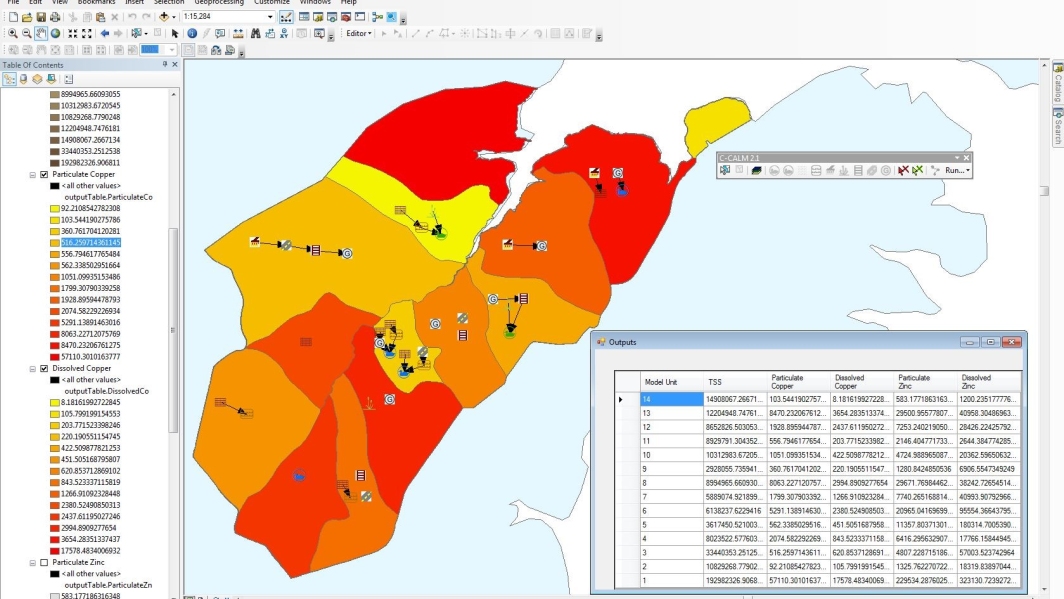Chemical contaminants are chemicals toxic to plants and animals in waterways.
The phrase 'chemical contamination' is used to indicate situations where chemicals are either present where they shouldn’t be, or are at higher concentrations than they would naturally have occurred. Chemical contaminants can be found as organic and inorganic molecules in mass produced products used day to day by almost everybody. These include plastics, resins, pharmaceuticals, disinfectants, deodorants, detergents, petroleum products, road runoff, pesticides and biocides, along with the results of land fill and incineration.
For many of these substances accumulation into aquatic environments can cause environmental problems, although some chemical contaminants do not damage the environment, and for many chemical contaminants the consequences are currently unknown. Chemical contaminants are often transported by water as it flows across the land, roads, and other impermeable surfaces. With little prior treatment, many of these contaminants may eventually discharge into waterways.
Some contaminants can increase bacteria growth and oxygen consumption within a waterway. In extreme cases, such as a large spill of sewage or milk, low oxygen conditions may kill mahinga kai species. Lower levels of nutrient contamination in waterways can result in eutrophication. Most eutrophication is due to the inorganic nutrients nitrate and phosphate that induce the growth of algae. The algae subsequently die, resulting in more organic matter and low oxygen conditions.
Find out more about eutrophication
Find out more about nutrient overloading
There are two types of chemical contaminants:
(1) Organic contaminants
These include oil and petrol spills from roads and concreted areas, hormones, pesticides, herbicides, and fungicides originating from agricultural and horticultural industries that are situated close to waterways. Organic contaminants are not only present as single molecules dissolved in water but can also be found as suspended solids.
Find out more about potential agricultural effects on waterways
Find out more about potential horticultural effects on waterways
(2) Inorganic contaminants
Inorganic contaminants include nitrogen (N), phosphorus (P) and potassium (K). Increases in these simple chemicals in waterways are nearly always as a result of land use activities like fertiliser runoff or direct discharges from industry. Both the concentration of these chemicals and the means by which they enter a waterway vary greatly. The impacts of these simple chemicals are discussed in the nutrients pages. Inorganic contaminants also include metals and metal particles. These can be found in stormwater runoff from urban development and will accumulate in drainage systems or low lying areas of land. Many of these contaminant sources eventually discharge into waterways with little prior treatment to remove chemicals.
Find out more about nutrient overloading
Find out more about potential urbanisation effects on waterways
Alternatively, industries like forest processing, meat and dairy processing, mining, energy, and wastewater treatment may discharge wastewater that can potentially contain inorganic chemical contaminants (e.g., bleach and curing agents, and certain metals like mercury, copper, chrome, zinc, iron, arsenic, and lead). Prior treatment of these discharges is now strictly regulated and controlled via the resource consenting process, and will vary depending on the type and quantity of material discharged.
Find out more about potential wood processing effects on waterways
Find out more about potential meat and dairy processing effects on waterways
Find out more about potential mining effects on waterways
Find out more about potential energy industry effects on waterways
Find out more about potential wastewater treatment effects on waterways
Potential impacts of chemical contaminants on water quality and mahinga kai
- Local loss of fish species - fish may be harmed by contaminated water. Discharges and runoff into rivers and streams can be lethal to aquatic life depending on the strength of the toxin and size of the waterway; contamination can cause fish kills.
- Local loss of invertebrate species - contaminants, such as synthetic pyrethroids (in sheep dip), can be particularly lethal to invertebrates, e.g., kōura. Invertebrates are also food for fish, and persistent discharges that kill invertebrates could cause fish to travel farther in search of food and expose them to greater risks and stress.
- Decreased dissolved oxygen (DO) levels - waste compounds released into waterways initiate biochemical reactions that use up oxygen as the stream bacteria break down the organic matter (Biogeochemical Oxygen Demand, BOD). Excess nutrients can also lead to algal blooms, and oxygen is used up when the algae die and decompose. Fish ‘breathe’ oxygen through their gills; a decrease in available oxygen (anoxia) in the water column threatens their ability to respire, which may lead to death. Fish that tolerate low levels of dissolved oxygen (such as the introduced fish gambusia) may replace native populations that are less tolerant.
- Increased turbidity and decreased water clarity - water may become cloudy or discolored with chemical contamination which reduces the ability of fish to see prey and detect predators.
- Damage to species - repeated exposure to sub-lethal doses of some contaminants can cause physiological and behavioural changes in fish that have long term effects on the population, such as reduced reproductive success, abandonment of nests and broods, a decreased immunity to disease, tumors and lesions, impairment of the central nervous system, and increased failure to avoid predators.
- Some contaminants, such as mercury, may bioaccumulate in animal tissues and be carried to human consumers of the fish.
Related links
-

Mitigation
Simple steps to minimise the effects of chemical contamination on water quality and mahinga kai.

